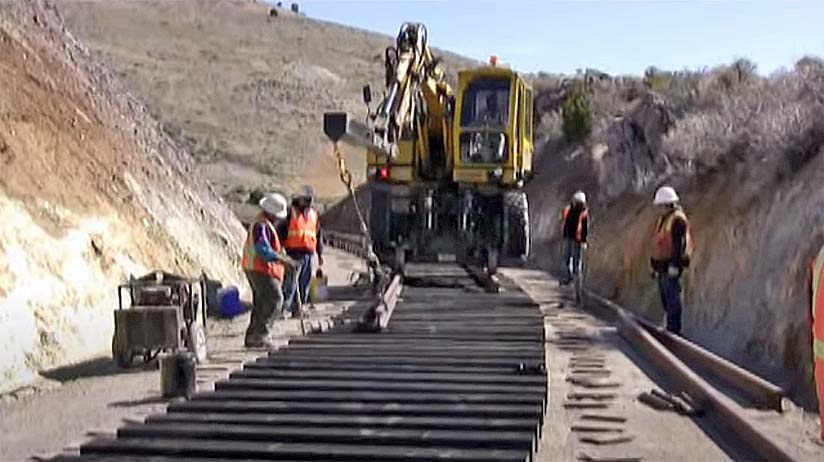
Mound House Nevada - New rails were hammered into place for Phase 2 of the V&T Railway reconstruction 11 Apr 2008, but they sure don't do it the way they used to, according to local newspapers.
The Virginia & Truckee was built in 1869 by private investors to connect the silver mines of Virginia City, Nevada, to the mills in Carson City, Nevada.
The rails were set and the spikes driven in by hand by about 1,500 workers, most of them Chinese.
The workers back then wouldn't recognize most of the modern tools used to install the rails today.
Now, the railroad construction workers from H&H Engineering of Stockton, California, use a huge Geismar 360 crane, which puts the rails in place.
Then a pneumatic spike driver installs the spikes.
But the men of the past would recognize the hammers.
Though much of the work is done with state-of-the-art equipment, project engineer Ken Dorr said some of it is still done by hand.
"If you are replacing ties, or for normal maintenance, you do them by hand," Dorr said.
But mostly the men only used the hammer to set the spike.
One worker uses a clawbar, or spike extractor, to lift up the ties against the rail, while another drives it in with the pneumatic driver.
"It's a lot easier than doing it the old way, but it's still pretty hard work, even with all the equipment," Dorr said.
"These guys work their butts off."
The workers are installing rails for the next four-and-a-half miles, which will get the track down to the Frehner Pit in Mound House, Dorr said, adding that the crews install about 750 feet of rail a day.
Dorr said the crews hoped to be farther along in the project, but winter snows held them back.
He said the rails were purchased from A&K Railroad Materials by the Nevada Commission for the Reconstruction of the V&T Railway, which is in charge of the project.
"We bought about 10 track miles worth of rails," he said, adding that the rails were made in the 1940s and 1950s and came from the Southern Pacific line near Alturas, California.
The next step will be to install the ballast, which Dorr said should begin in a week or two.
Author unknown.
(because there was no image with original article)
*2. Original news article image replaced.
(because it was a poor photo)
provisions in Section 29 of the Canadian
Copyright Modernization Act.
